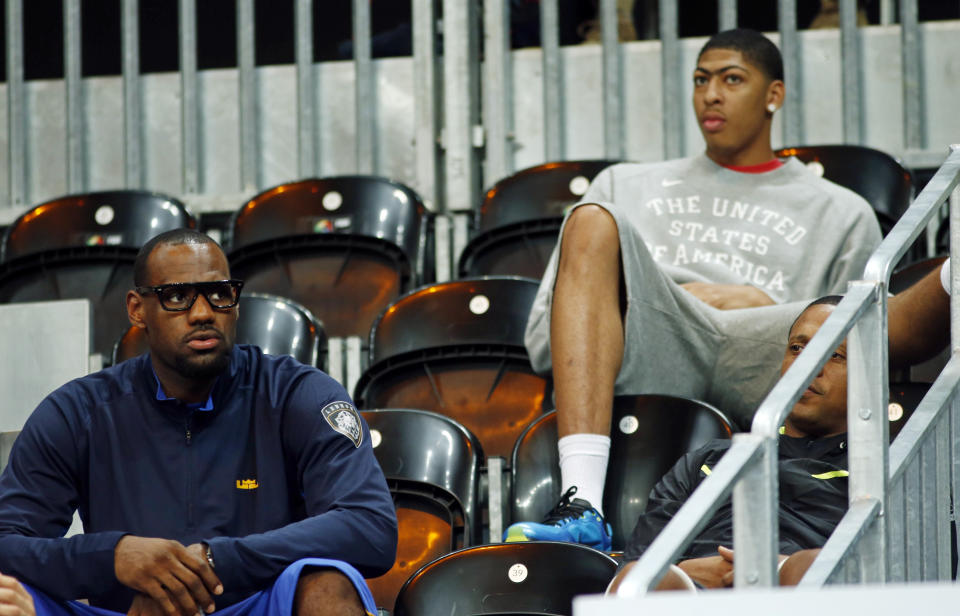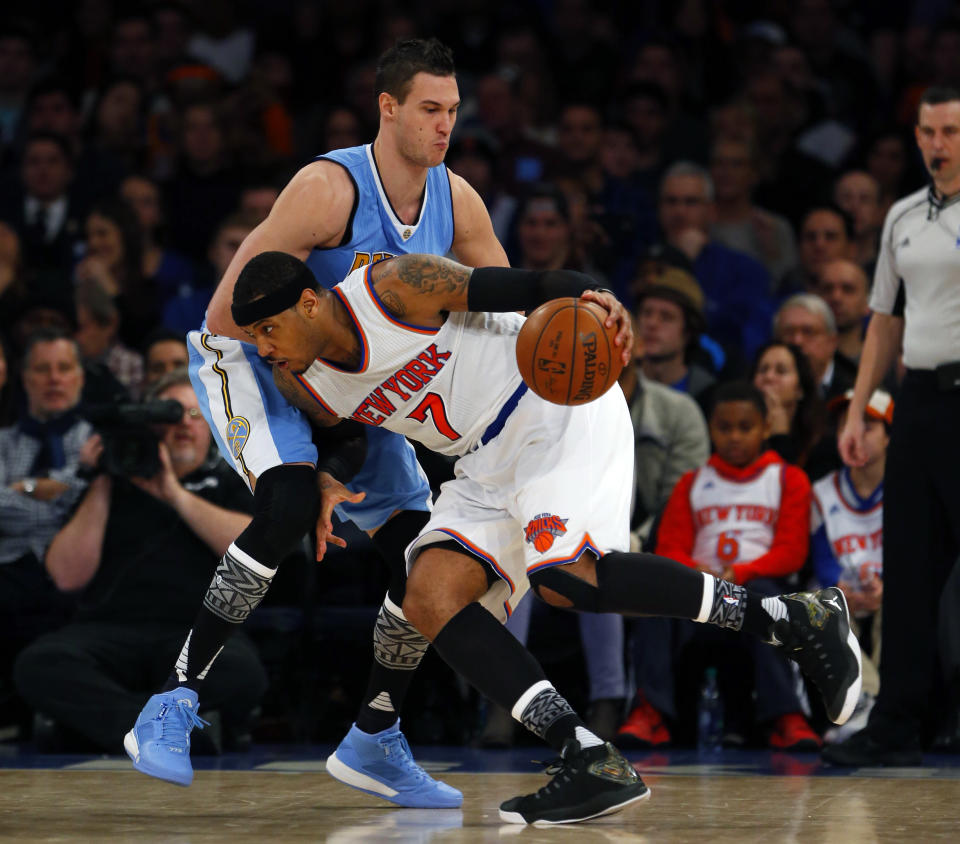How does the Anthony Davis trade compare to the decade's NBA mega-deals?
There is no historical precedent in the NBA for a package of trade assets as significant as what the Los Angeles Lakers gave up for Anthony Davis on Saturday.
The New Orleans Pelicans received Brandon Ingram, Lonzo Ball, Josh Hart, what amounts to three unprotected first-round picks and a 2024 first-round pick swap. With Ingram, Ball and the No. 4 overall selection in this week’s draft all heading to New Orleans, the Pelicans essentially get three top-five picks in addition to (essentially) unprotected first-rounders in either 2021 or 2022 and 2024 or 2025.
The closest comparison is probably the 2013 blockbuster between the Brooklyn Nets and Boston Celtics. In exchange for Kevin Garnett, Paul Pierce, Jason Terry and D.J. White, the Celtics also received three unprotected first-round picks and a pick swap in addition to salary filler. Those picks proved to be the bedrock of Boston’s 2017 and 2018 Eastern Conference finals runs, ultimately netting Jaylen Brown, Jayson Tatum, two years of Kyrie Irving and this year’s No. 14 pick.
The difference here is that the Lakers landed Davis, a 26-year-old perennial MVP candidate presumably in the onset of his prime. The Nets got a 37-year-old Garnett, a 36-year-old Pierce and a 35-year-old Terry. With LeBron James also on the roster, the Lakers are less likely to convey consecutive No. 3 picks down the line, although that will largely depend on the health of Davis and an aging LeBron, their respective 2020 and 2021 free agencies, and the team’s ability to surround them with talent.
Despite the acquisition of Davis alongside LeBron — an unprecedented pairing, given they own two of the three best career player efficiency ratings in NBA history (Michael Jordan is the other) — the Lakers took a considerable risk in ceding control of their first-round picks for the next six years. By trading Ingram and Ball, the Lakers also relinquished the last remaining lottery picks from the past six years.

All of which leaves Kyle Kuzma as the only other established rotational player under contract. Lakers general manager Rob Pelinka may only have $23.7 million in salary cap space, a $4.76 million cap room midlevel exception and minimum contracts to fill out a seven- or eight-man playoff rotation. Ring-chasing veterans and buyout candidates make that all the more possible this season, but beyond then LeBron will be on the other side of 35 years old, and that puts a hefty onus on the shoulders of Davis, who has played more than 70 games twice in seven seasons.
It is almost impossible to grade the trade now, since we do not know if Ingram or Ball will ever meet his considerable potential and what becomes of the future picks. What we do know is that Pelicans vice president of basketball operations David Griffin has just landed a historically great collection of assets with which to build around No. 1 overall pick Zion Williamson. How Griffin spends the rest of his picks from here on out will largely determine the final grade of this deal for New Orleans.
As for the Lakers, recent history tells us that trading a first-team All-NBA talent in his prime for a collection of assets is merely a coin-flip proposition. Prior to 2010, that was not the case. The team that landed the superstar almost always won the trade, as Bill Simmons detailed in a 2011 column. The final three mega-deals of last decade — Shaquille O’Neal to the Heat in 2005, Kevin Garnett to the Celtics in 2007 and Pau Gasol to the Lakers in 2008 — all directly resulted in championships.
Since then, there have been five deals involving top-flight MVP candidates this decade. The team dealing the superstar won two of those trades, and the team receiving the superstar won two of those trades. The fifth resulted in good fortune for both sides. Only one has directly resulted in a title: your 2019 Toronto Raptors.
Here’s how the five other blockbuster trades this decade have panned out ...

2011: New York Knicks get Carmelo Anthony
What did the Denver Nuggets originally get in return?
They got: Danilo Gallinari, Wilson Chandler, Timofey Mozgov, Raymond Felton, a 2014 first-round pick, two second-round picks and a first-round pick swap in 2016.
What have the Nuggets actually gotten in the deal?
The Nuggets traded the 2014 first-round pick that became Dario Saric in a four-team deal (more on this later) that netted them Andre Iguodala, and they swapped Felton for Andre Miller. That laid the foundation for a team that peaked with 57 wins in 2012-13 and lost in the first round to the nascent Golden State Warriors.
Here’s the kicker, though: The 2016 pick swap got them Jamal Murray, the second-best player on a 54-win team that came within a quarter of the Western Conference finals this season. The Anthony deal is somehow still paying dividends for Denver.
It could have netted the Nuggets even more, if they hadn’t wasted the two first-round picks they got from Cleveland in return for Mozgov. They spent one salary-dumping JaVale McGee in 2017 and attached the other to Jusuf Nurkic in return for Mason Plumlee. Those two picks became Furkan Korkmaz and Harry Giles.
This is a helpful reminder that the decisiveness of Saturday’s trade will largely depend on how prudent Griffin is with the picks coming his way from the Lakers.
How did the Knicks fare with Anthony?
The Knicks made the playoffs in their first three seasons with Anthony, peaking with 54 wins and a second-round playoff exit in 2013, when he finished second in MVP voting. They have not made the playoffs since, ultimately trading Anthony in a 2017 deal that has currently left them with Mitchell Robinson and Emmanuel Mudiay.
The decision by the Knicks to gut their roster and few remaining draft assets for Anthony, when they could have waited to sign him outright in 2012 free agency, set their roster-building efforts back significantly. This is strikingly similar to Saturday’s deal for Davis, who reportedly plans to sign with the Lakers in 2020 free agency.
Who won the trade? Denver.
2012: Los Angeles Lakers get Dwight Howard
What did the Orlando Magic originally get in return?
They got: Arron Afflalo, Al Harrington, Nikola Vucevic, Josh McRoberts, Moe Harkless, Christian Eyenga, one protected future first-round pick from each team of the three other teams involved in the deal and two second-round picks.
What have the Magic actually gotten in return?
The Magic sent two of those conditional first-round picks back to the Philadelphia 76ers to move up two spots and take Elfrid Payton 10th overall. The protections on the final first-round pick turned it into second-rounders in 2017 and 2018, which have left them with Wes Iwundu and — in a roundabout way — GM Jeff Weltman.
One of the second-round picks Orlando originally acquired never conveyed, and the other was used to draft the immediately waived Romero Osby. This all illustrates both the value of protections and the trouble with valuing picks before they convey.
Vucevic was far from the prospect that Ball and Ingram are now, and yet he ultimately became the best player in this deal, which goes to show how much these deals change over time. Vucevic made his first All-Star team in 2019, averaging an efficient 20.8 points, 12 rebounds and 3.8 assists for the Magic this past season.
On top of that, the Magic turned Afflalo into Evan Fournier, and he also started for a Magic team that made the playoffs for the first time since trading Howard in 2012.
How did the Lakers fare with Howard?
Howard spent one season in Los Angeles, feuded with Kobe Bryant over his perceived softness (despite Howard playing through back and shoulder injuries) and left in 2013 free agency. The Lakers suffered a first-round sweep in their only campaign with Howard, in large part because Bryant tore his Achilles tendon playing 48 minutes a night in an attempt to drag the team to the playoffs.
The Lakers have to be crossing their fingers that the Davis/LeBron pairing doesn’t mirror the disparity between the expectations for the Howard/Bryant combination and the combustibility that was uniting a young superstar with a demanding legend.
Who won the trade? Orlando.

2012: James Harden to Houston Rockets
What did the Oklahoma City Thunder originally get in return?
They got: Kevin Martin, Jeremy Lamb, a pair of protected first-round picks in 2013 and a 2013 second-round pick.
What have the Thunder actually gotten in return?
The first-round picks became Steven Adams in 2013 and Mitch McGary in 2014, and the Thunder also nabbed Alex Abrines at No. 32 with the second-round pick.
Adams was a starter on the OKC squad that nearly toppled the Warriors in the 2016 Western Conference finals, and Abrines has also been a contributor to Thunder teams that have been ousted in the playoffs each of the past three seasons.
A case could be made that not one of those assets that OKC received was as valuable in the moment as any of the six pieces New Orleans got in return for Davis.
How have the Rockets fared with Harden?
The Thunder would have clearly been better off with Harden. He will undoubtedly finish in the top two in MVP voting for the fourth time in five years when the awards are announced next week, and he took home the honor last season. Harden has consistently submitted some of the greatest offensive seasons in NBA history.
The Rockets also came within a game of reaching the Finals with Harden at the helm last season. After a three-year drought prior to trading for the Sixth Man of the Year, Houston has made the playoffs in each of the seven years since, including two conference finals appearances and a first-round win against the Thunder in 2017.
We might feel differently about the deal if the Thunder had drafted Giannis Antetokounmpo over Adams in 2013 or Nikola Jokic in 2014, but such is the gamble of trading the certainty of a 20-something star for unknown draft picks.
Who won the trade? Houston.
2017: Oklahoma City Thunder get Paul George
What did the Indiana Pacers originally get in return?
They got: Victor Oladipo and Domantas Sabonis.
What have the Pacers actually gotten in the deal?
Oladipo and Sabonis. It’s just that Oladipo turned into an All-NBA guard, and Sabonis became a legit Sixth Man of the Year candidate. Together, they have helped Indiana reach the playoffs each of the past two years. They gave LeBron James’ Cavaliers all they could handle in the 2018 first round, and then were swept by Boston this season — after Oladipo suffered a year-ending knee injury.
How have the Thunder fared with George?
The Thunder traded for George with less of a guarantee that he would re-sign in 2018 free agency than the Lakers have from Davis. He was an All-Star in his first campaign with OKC, enjoyed his time so much that he re-signed for four more years, and then submitted a top-three MVP candidacy this past season. Both years have also ended in first-round exits in the face of a loaded Western Conference.
Who won the trade? Even.

2018: Toronto Raptors get Kawhi Leonard
What did the San Antonio Spurs originally get in return?
DeMar DeRozan, Jakob Poeltl and Toronto’s protected 2019 first-round pick.
What have the Spurs actually gotten in the deal?
That first-round pick from Toronto now sits second from the bottom in this year’s first round. The Spurs made the playoffs in their first post-trade season. Both DeRozan and Poeltl started in their seven-game, first-round loss to the Nuggets.
How have the Raptors fared with Leonard?
They won the damn title, which is why you trade for a talent of his ilk. This is the most compelling reason to deal for Davis. It should be noted how little draft compensation the Raptors gave up, and they got Danny Green back in return, too. Toronto also had a playoff rotation to plug Leonard and Green into. It remains to be seen whether the Lakers can surround LeBron and Davis with a viable roster.
Who won the trade? Toronto.
– – – – – – –
Ben Rohrbach is a staff writer for Yahoo Sports. Have a tip? Email him at rohrbach_ben@yahoo.com or follow him on Twitter! Follow @brohrbach
More from Yahoo Sports:


